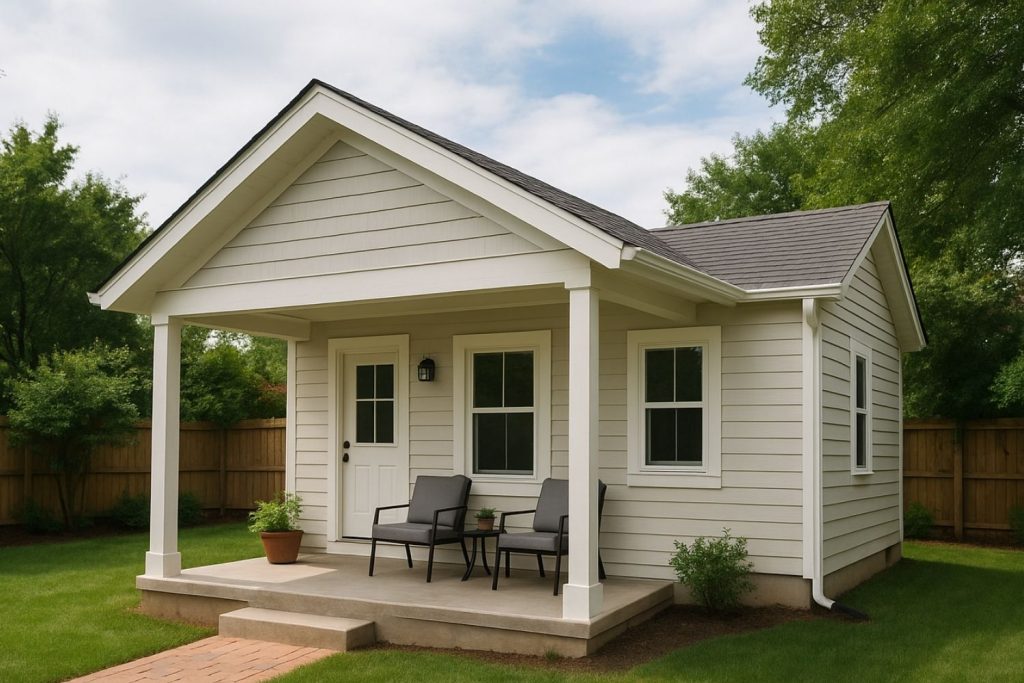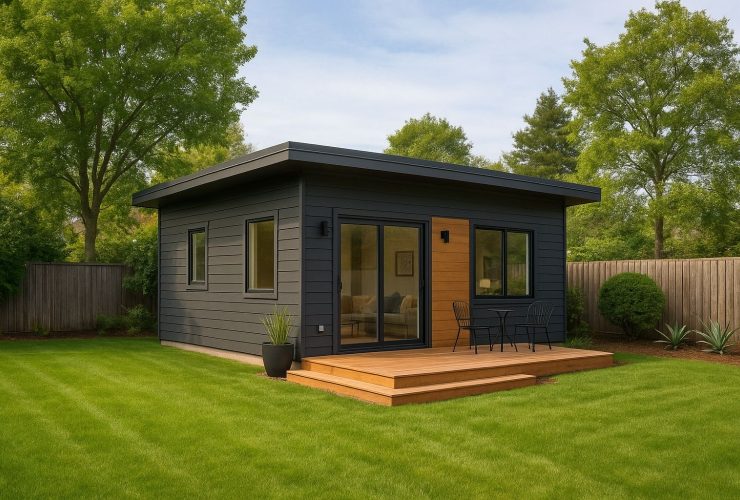Roughly 1 in 4 ADUs in California are believed to be unpermitted, often built without inspections or proper approvals in response to rising housing costs and limited space.
As cities work to expand affordable housing options, many homeowners are realizing that their illegal ADU could be both a liability and a missed opportunity.
As an expert in home inspections, I’ve seen firsthand how common it is for backyard conversions, garage apartments, or basement units to be built without the right permits.
These unpermitted ADUs often start as well-meaning projects but can lead to serious safety risks, insurance gaps, and legal headaches if not brought into compliance.
In this article, we’ll walk through how to legalize an unpermitted ADU, covering:
- What defines an unpermitted ADU and why it’s risky to leave it illegal.
- How to begin the process with a private inspection and code assessment.
- What’s involved in preparing plans and submitting for an ADU permit.
- How local laws like California’s AB 2533 support legalization efforts.
- The financial and safety benefits of having a legal, insurable ADU.
By the end of this post, you’ll know the exact steps to permit an unpermitted ADU safely and legally and how to turn a code risk into a valuable, compliant part of your property.
Understanding What Makes an ADU Unpermitted
What Is an Unpermitted ADU?
An unpermitted ADU is a secondary housing unit, such as a converted garage, basement apartment, or standalone backyard cottage, that was built or renovated without securing the necessary ADU permits or undergoing required inspections.
These units often bypass city planning and building departments, which means they may not comply with current safety or zoning standards.
Risks of an Illegal ADU
Operating an illegal ADU can create serious problems for homeowners:
- Safety Hazards: Without inspections, issues such as faulty electrical wiring or inadequate exits may go unnoticed.
- Insurance Gaps: Insurance companies may deny claims if damage occurs in an unpermitted unit.
- Fines and Enforcement: Cities can issue steep fines or require complete removal of the unit.
- Sale Complications: Unpermitted units can complicate property sales or reduce home value.
Common Examples I’ve Seen
As someone who inspects homes regularly, I’ve seen many ADUs fail due to missing smoke detectors, no emergency exit windows, and improperly installed electrical panels. These are not just code violations; they can be life-threatening in an emergency.
Initial Assessment and Inspection
Why Start With a Private Inspection
Before contacting the city, it’s smart to bring in a licensed inspector or contractor for a private assessment. This avoids triggering code enforcement while giving you a clear picture of what needs fixing. It also helps you build a roadmap for bringing the unit into compliance.
What Inspectors Look For
During a private inspection, the focus is on safety and code compliance. Inspectors typically check:
- Electrical panels and wiring.
- Plumbing systems and drainage.
- Egress windows and emergency exits.
- Ventilation and natural light.
- Smoke and carbon monoxide detectors.
- Structural integrity (walls, ceilings, and foundations).
Creating a Roadmap
Once the inspection is complete, you’ll have a list of deficiencies and potential upgrades. This helps estimate costs and determine if your unit qualifies for local amnesty or streamlined legalization programs that prioritize safety over full modern code compliance.
Preparing the Plans and Permit Application
Gathering Documentation
If you have any old building permits, photos, or records showing when the ADU was built, gather them now. These can be used to prove the unit existed before certain cutoff dates, which may qualify it for amnesty programs like those in California.
Hiring a Qualified Designer or Architect
To meet zoning and building code requirements, you’ll likely need a professional to draft plans.
Doing so will streamline the process, help you avoid costly mistakes, and ensure permit approval as quickly as possible.
Submitting the Permit Application
Your complete application will include:
- Site plans and floor plans.
- Structural and safety details.
- Documentation for amnesty eligibility (if applicable).
- A statement of intent to legalize the unit.
Submit your application to the local planning or building department. Some cities may route your plans through multiple departments for review.

The Review and Inspection Process
Multi-Agency Review
Once submitted, your application may be reviewed by several departments:
- Building Department: Structural safety and code compliance
- Fire Department: Emergency access and smoke detectors
- Health Department: Sanitation, plumbing, and ventilation
- Planning/Zoning: Lot coverage, height, and setbacks
Each department ensures that the unit meets the respective standards.
Streamlined and Amnesty Programs
Cities such as Los Angeles, Oakland, and Mountain View have created programs to simplify the process. These programs often waive penalties and allow units to be legalized as long as they meet basic safety requirements.
California Example: AB 2533
California’s AB 2533 makes it harder for local governments to deny legalization based solely on the fact that a unit was originally unpermitted. As long as there are no serious health or safety hazards, cities must allow the unit to be legalized.
Many ADU builders, such as LADU, specialize in this legalization process. I spoke with Babak Mortazavi, the founder of LADU, who said “homeowners with unpermitted ADUs need to take advantage of AB2533, it allows them to avoid penalties for their original unpermitted ADU, as long as they follow the proper steps to rectify the situation.”
Making Required Corrections
Typical Corrections Needed
Most unpermitted ADUs don’t need to be torn down. Common upgrades that bring units into compliance include:
- Installing smoke and carbon monoxide detectors.
- Adding GFCI outlets in kitchens and bathrooms.
- Providing emergency egress windows in bedrooms.
- Fixing minor plumbing leaks or drainage issues.
- Improving ventilation or HVAC systems.
Cost Considerations
Costs can vary widely depending on the scope of work. A simple retrofit with smoke detectors and electrical fixes might cost a few thousand dollars. More extensive repairs such as plumbing or structural work can add up. Early planning with a qualified contractor helps reduce surprises.
Levi Construction, an ADU builder serving Los Angeles, Orange, and Ventura counties in California, advises planning for unexpected costs, such as asbestos removal, utility upgrades, mold remediation, and foundation reinforcement, early in the process.
Special Zones and Exceptions
If your property is in a coastal, hillside, or historic zone, additional rules may apply. These areas may require extra documentation or design review, but public hearings are usually not needed for ADU legalization.
Complying With Local Zoning Laws
Zoning Factors To Check
Even if your ADU is structurally sound, it must comply with zoning laws. Common requirements include:
- Minimum lot size.
- Setback distances from property lines.
- Maximum unit height and square footage.
- On-site parking requirements.
- Limits on the number of occupants.
Regional Differences
In New York City, Local Laws 126 and 127 provide a 10-year path to legalize basement and cellar units, with safety and zoning milestones along the way. New York’s Plus One ADU Program also enables a smooth compliance process.
In New Jersey, requirements vary by town, but most require full compliance with zoning and building codes.
When Zoning Blocks Legalization
If your ADU violates zoning rules, you may have options:
- Apply for a variance or zoning exception.
- Modify the unit’s layout to comply.
- Participate in a local pilot or amnesty program.
Cities are increasingly open to creative solutions, especially when the unit provides much-needed housing.
Final Approval and Legalization
Final Inspection
After corrections are made, a city inspector will visit to confirm compliance. They’ll check that all safety features are installed correctly and that previous violations have been addressed.
Certificate of Occupancy and Registration
Once the unit passes inspection, you’ll receive a certificate of occupancy. This document officially confirms that the unit is legal and safe for habitation. In some cities, you may also need to register the ADU with the local housing department.
Owner-Occupancy and Rental Rules
Some jurisdictions require the property owner to live on-site, especially if the ADU is being rented. Others may limit short-term rentals or require minimum lease lengths. Be sure to review your city’s rental guidelines before listing the unit.
Benefits of Legalizing an ADU
Avoiding Penalties and Enforcement
Legal ADUs are protected from fines, forced removal, or tenant displacement. You gain peace of mind knowing your unit complies with the law.
Improved Property Value and Insurance
A legal ADU increases your home’s value and allows you to insure the unit properly. If something goes wrong, your insurance will cover the damages.
Rental Income and Affordable Housing
Legal ADUs can be rented out, providing extra income. In many cities, they play a key role in increasing affordable housing options for renters.
Legal Status Starts With a Plan
Legalizing an unpermitted ADU is a process that starts with a careful inspection and ends with official approval. Most units only require targeted safety upgrades, not complete reconstruction.
Laws such as California’s AB 2533 and New York’s Plus One ADU Program make the path to compliance more accessible than ever.
As an inspector, I’ve seen how a well-structured plan can turn a risky, illegal ADU into a safe and valuable part of your property.
If you’re not sure where to begin, your local permitting office or a certified inspector can help you take that first step toward legal, worry-free housing.
